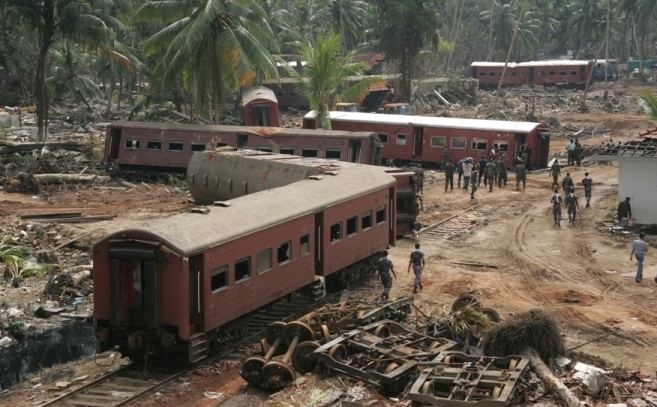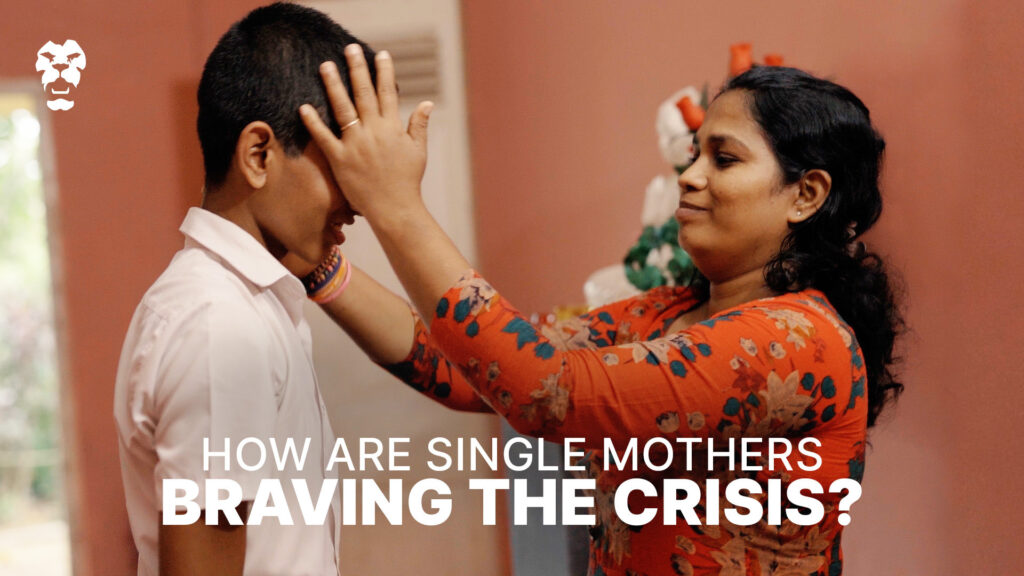
Hiruni Wanniarachchi has been missing since 26 December 2004, the day the Indian Ocean Boxing Day tsunami hit Sri Lanka’s coast. The then seven-year-old was travelling with her parents and sister, seven years her senior, on the Matara Express, the Galle-bound train that was caught in the disaster. For over 17 years now, Hiruni’s parents — who believe she is alive — did everything to find her. But with nearly two decades passed with no new information or evidence of her existence, the weary family is giving up their search.
“I [still] believe she is alive, based on all the evidence we managed to find,” Naduni (32), Hiruni’s older sister, told Roar Media, at their residence in Kirulapone. Hiruni’s portrait, of a little girl dressed in pink, is placed near the doorway of the house. The last time the family received any new evidence suggesting Hiruni may have survived the disaster was in 2005. Since then, everything suggested or promised has turned out to be a lie or a scam or led to a dead end.

Tragedy On A Train
It was Hiruni’s first trip by train. The family’s plan was to travel to the south for the Christmas and following Poya holiday to visit Hikkaduwa with their relatives.
When the first wave struck, the Wanniarachchi family was among the 1,500 people on board the now the infamous Train No. 50 — Matara Express — which had by then reached Peraliya, a small coastal village in Hikkaduwa. Naduni recalled the panic they felt after the first wave hit them; the water had reached their ankles inside the train carriage, and her mother, Chandralatha Gamage (now 61) had carried Hiruni, the youngest in the group, and placed her on the overhead luggage rack, telling her to hold on tight.
It was then that the second wave struck.
“For several years, the sound of water would scare me,” Naduni said. “If someone opened the tap and I heard the water gushing out, I would scream and scream until they turned it off.”
The wave toppled the train and dislodged its carriages, in what would become one of the worst railway disasters the country ever faced. It was Naduni’s father, Nihal (now 66), who pulled her out of the submerged carriage. They found each of their relatives subsequently — even the body of a teenage cousin who was initially missing — but Hiruni was nowhere to be found.

First Sighting
Hiruni’s family was determined to find her. Nihal would travel all the way from their home in Kirulapone, in Colombo, to Telwatta in the south, almost every day. It was then that they received one of the first and most promising pieces of evidence that suggested Hiruni’s survival.
Sirithunga, a resident of Aluthwala in the south, contacted the family after seeing a poster the family had put up in the Telwatta area seeking information about Hiruni. Sirithunga had lost his wife to the waves on the 26th, but had come across a girl — he believes it was Hiruni — on a tree. He had rescued the girl and sent her along with his own daughter to a nearby temple before continuing to look for his wife. His daughter had lost track of the rescued girl at the temple.
“Sirithunga mama and his daughter were the first people to call us with some information about Hiruni,” Naduni recalled.
Other sightings of Hiruni were also reported — some claimed to have seen her being “taken away” by two boatmen in Matiwela, another village in the south. One of these men was later arrested for ‘selling’ a boy who lost both his parents in the tsunami to a different family — an act that came to be notorious in the aftermath of the tsunami, leading the government at the time to subsequently issue a ban on the adoption of children orphaned by the tsunami.
“When the police arrested the man and found the boy who was sold, he [the boy]claimed there had been two girls with him before he was sold. [One of them] could have been my sister, but we don’t know for sure,” Naduni said.
A news segment by NHK World News that showed the sting operation led by the Sri Lanka Police and the National Child Protection Authority (NCPA), in tracking down and arresting a child trafficker in 2005. Video credits: Wijesena Withana, a former officer in charge of the Special Police Investigation Unit of the NCPA.
The Phone Call
In early January 2005, Nihal was invited to a television programme, during which he shared Hiruni’s story. He also shared photographs of her, and the poster the family had made seeking information about her.
“The next day, we received a call on our landline,” Chandralatha, Hiruni’s mother said. “My husband had gone to Telwatta again, following another lead. I was the only one at home, and I remember it was around 10:00 in the morning.”
The woman at the other end of the call said she was calling after seeing the programme on TV the previous night. She said her family had not wanted her to make the call as it may cause them problems, so she had called when no one else was home.
“That girl was brought here,” the woman told Chandralatha. “She was brought in a van. That girl is alive. I will call back and give you more details.”
Since the call came through the landline, Chandralatha did not have the number of the person who called, but she wrote down the time as 10:00 AM. “I called my husband too, and told him about the phone call,” she said. But a few hours later, when she checked the clock, to her dismay, she saw the same time: 10:00 AM. “The clock had stopped working,” she said.
The family used what resources and contacts they had to obtain a record of the calls received that day from the telecommunications company. But the list of phone numbers did not show any incoming calls throughout that day; there were only outgoing calls.
“Everyone thought my mother had imagined the call due to the stress she was going through, which she refutes to this day,” Naduni said. “It was only several years later that we realised the list of numbers given by the communications provider had listed only outgoing calls, not incoming calls. And it was too late to look back at the records.”
The person who contacted them that day never called again.

A Desperate Search
Over the years, with no new information coming in, the family became more and more desperate to find their missing daughter. “We tried other means of finding her as well,” Naduni said. “We met with soothsayers, astrologers, black magicians, and all sorts of spiritualists who promised to find my sister in a month, in 21 days, before the New Year. We were desperate, so anyone who offered to help, we listened.”
I did not believe a single person who claimed some god or spirit spoke to them and told them that my daughter was alive,” Chandralatha said, rage burning in her eyes. “They all lied.”
All of these seers instructed the family to engage in exhaustive rituals — one which even involved finding a fresh grave and padding it with bull manure. Firm Buddhists, she and Naduni have now lost faith in the occult.
“Desperate families go to them [astrologers] and do everything they say regardless of how much money and time it costs,” Chandralatha said. “Even though we consulted them, I didn’t believe in any of it, and I didn’t [even] want to pay them [but I did it]. I’m not afraid of ghosts or spirits. The only thing I’m afraid of is other people.”
The family was even contacted by an incarcerated con-man. The man had seen Hiruni’s ‘missing’ posters and had contacted the family, claiming he had information. He had described her features — which didn’t prove he had met the girl, Naduni said because the posters carried a photo of Hiruni anyway — and asked them to come to visit him for more information.
“His goal was to get out of prison and to get bail by pretending to know where my sister was. My father went with the authorities, in search of the location the inmate had provided. They checked houses and families there but it was a dead end. It was a lie.”
People who shared the story of Naduni’s search for her sister on social media were also contacted by people who thought they had information, or were trying to help the Wanniarachchi family.
“One girl [who shared the post about my sister on social media]sent me a message saying that several people contacted her asking her if she was the girl who went missing after the tsunami,” Naduni said. “She was contacting me to say that she wasn’t my missing sister. It was a very uncomfortable situation for me. They want to help, but the way they try is not helpful at all. It is inconvenient for everyone.”
Naduni and her family made a video about Hiruni and her story last year and published it on YouTube.
‘We Hope She Lives A Good Life’
Around 31,229 lives were lost in Sri Lanka due to the tsunami, according to official records, and over 4,000 people whose bodies were never recovered are believed to be dead. The Forensic Unit of the Karapitiya Teaching Hospital handled over 1,100 deaths, and of these, about 450 unidentified bodies were dispatched for mass burial, after external appearances and all other important personal data had been recorded. This helped officials establish the identity of 120 other victims in the six weeks that followed.
But the chaos of the situation created circumstances that allowed for abductions, child exploitation, and trafficking. A lack of public awareness and experience with a natural disaster of this scale, meant that even the authorities were at a loss as to how to deal with what ensued at the time.
The National Child Protection Authority (NCPA), an institution responsible for the welfare of children (established only a year before the disaster), was one of the leading organisations assisting in the search for missing children. The NCPA also assisted an association formed by families whose relatives had disappeared during the tsunami. The group, which Naduni and her family were part of, has since disbanded.
But despite the years that have passed, and despite the lack of concrete evidence, Naduni and her mother hang onto the belief that Hiruni is alive.
“There was so much anecdotal evidence that pointed to the fact that she is still alive,” Chandralatha said. “If she is living somewhere, we hope she is living happily, leading a good life. But we cannot run behind rumours and false leads anymore.”
“Sometimes I think she may have forgotten us because of the trauma,” she continued. “But it is also possible that, over the years, her memories may come back. [But] there is no point in pursuing this without any new information.”
“There are times I feel like I could have done more. Looked for her more on that day. I don’t know if we searched enough,” Naduni said. “But I’m not capable of searching every house, every village.”
She also wishes that on the day they lost her, the family had thought of splitting up and searching for Hiruni in different places — but at the time, traumatised and fearful about losing each other again, the family had stayed together.
“That feeling of guilt lingers always in my mind,” Naduni said. “I question what more I could do.”
The Wanniarachchi family that has searched for missing Hiruni for 17 years with no success is now laying it to rest. Their hope is that they could have one glimpse of her at least, one day, and that she is living well — nothing else.








